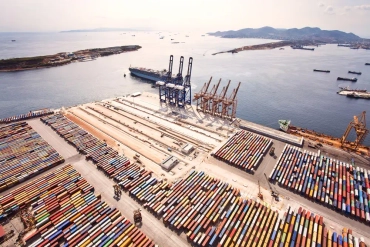
Peru’s Top 5 Major Ports



There are over 100 port facilities available in the Peruvian port system. These are classified as river, marine, and lake ports. Of the major coastal ports, Callao serves as the most important one with regards to cargo movement. This is due to the fact that 70% of the total loading and discharging of cargo in Peru happens in this port.
91% of total export volumes and 65% of the total export FOB values are handled by the ports in Peru. Bordering the Pacific Ocean, Peru has a long west coast. The presence of numerous ports in Peru isn’t surprising, as 90% of Peru’s exports are transported by sea.
Which are the Major Ports in Peru?
1. Callao Port
The port of Callao serves as the main port as far as traffic and storage capacity is concerned. Situated in the capital city of Lima on the central coast, it’s 16 meters deep, and allows for the loading of heavy shipments.
This particular terminal is connected to both Lima’s industrial zone as well as the rest of the country. The connection also extends to the Jorge Chávez International Airport, which crosses the Andes mountain range. It was reported that in the year 2017, container ships anchored about 19 hours in the South Pier and close to 23 hours in the North Pier on an average.
2. Paita Port
The Paita Port is the second largest national port in Peru as far as movement of containers is concerned, coming right after Callao. Situated north of the country in Piura, Paita comes third with regards to the total movement of cargo.
From October of 2009, the port started being operated by a Peruvian-Portuguese consortium known as Terminales Portuarios Euroandinos S.A. or TPE. In the end of 2016, it was reported that the volume operated within the port had reached over 215,000 TEU.
OSITRAN, which is the supervisory agency in Peru related to the investment in public transport infrastructure, stated that the operations in Peru are mostly oriented towards export. In the year 2016, close to 95% of the total export cargo was moved using containers. Among the many exported products, the main ones include hydro biological products such as fish, fish oil, and squid, and agro industrial items, namely grapes, mango, coffee, bananas, etc.
3. Matarani Port
Situated about 452 miles South of Callao, the Matarani Port is known to serve both the Southern Peruvian Region as well as the Bolivian main cities, namely that of Santa Cruz, Cochabamba, and Oruro, and several others.
Way back in 1999, the port was awarded in concession for 3 decades to a Romero’s group company named Terminal Internacional del Sur S.A. (TISUR). That’s what led to the multiplication of cargoes to and from Bolivia, and it’s also what increased the investment in port infrastructure.
4. Talara Port
Not only is the Talara port state-owned, but it’s also operated by the National Petroleum Company, Petróleos del Perú S.A. (PETROPERU). Different products are processed by the refinery, such as motor gasoline, solvents, A-1 turbo, diesel 2, LPG gas, industrial oils, and asphalts.
The Talara port serves the oil industry in the regions of Piura and Tumbes. The rest of the country has most of the production sold to them. The shipping takes place through their own loading pier. These are shipped to tankers moving towards the terminals of Chimbote, Supe, Callao, Eten, Salaverry, Pisco, Mollendo, and Ilo.
The entrance channel of the Talara port is positioned in the SE-NW direction, with the minimum width being 180 m and the water depth being 10⁄11 m. It can accommodate tankers up to 210 m, coupled with a max draft of 10.36 m, and 10.70 m at buoys.
The port contains a submarine line that is used to load and unload crude material. Since the vessels always move towards the southern region, there are six supporting mooring buoys.
5. Salaverry Port
The Salaverry port is actually an artificial harbor. It’s basically a pier port that comes in contact with surge and swell quite often. The port contains 700 m long breakwater and extensions. Although that has reduced, the issue of exposure to a small amount of surge and swell within the port operations area and the piers is yet to be solved.
The port serves Trujllo along with the neighbouring states of Ancash, Lambayeque, and Cajamarca. It falls under the administration of Empresa Nacional de Puertos S.A. (ENAPU). The port contains two solid piers that are employed to handle general as well as bulk cargo. This also includes making use of a mobile shore ship loader that loads copper concentrates.
Related Articles


